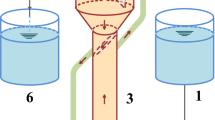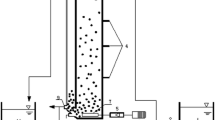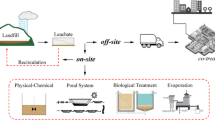Abstract
Abiological granular sludge (ABGS) formation is a potential and facile strategy for improving sludge settling performance during zinc removal from wastewater using chemical precipitation. In this study, the effect of pH, seed dosage, and flocculant dosage on ABGS formation and treated water quality was investigated. Results show that settling velocity of ABGS can reach up to 4.00 cm/s under optimal conditions, e.g., pH of 9.0, zinc oxide (ZnO) seeds dosage of 1.5 g/l, and polyacrylamide (PAM) dosage of 10 mg/l. More importantly, ABGS formation mechanism was investigated in NaOH precipitation process and compared with that in bio-polymer ferric sulfate (BPFS)–NaOH precipitation process regarding their sludge structure and composition. In the NaOH precipitation process, ABGS formation depends on some attractions between particles, such as van der Waals attraction and bridging attraction. However, during the BPFS–NaOH sludge formation process, steric repulsion becomes dominant due to the adsorption of BPFS on ZnO seeds. This repulsion further causes extremely loose structure and poor settling performance of BPFS–NaOH sludge.








Similar content being viewed by others
References
Baltpurvins KA, Burns RC, Lawrance GA, Stuart AD (1996) Use of the solubility domain approach for the modeling of the hydroxide precipitation of heavy metals from wastewater. Environ Sci Technol 30(5):1493–1499
Chen Q, Luo Z, Hills C, Xue G, Tyrer M (2009) Precipitation of heavy metals from wastewater using simulated flue gas: sequent additions of fly ash, lime and carbon dioxide. Water Res 43(10):2605–2614
Duan J, Gregory J (2003) Coagulation by hydrolysing metal salts. Adv Colloid Interf 100–102:475–502
Ferretti R, Stoll S, Zhang J, Buffle J (2003) Flocculation of hematite particles by a comparatively large rigid polysaccharide: schizophyllan. J Colloid Interf Sci 266(2):328–338
Fu F, Wang Q (2011) Removal of heavy metal ions from wastewaters: a review. J Environ Manage 92(3):407–418
Gregory J (2006) Particles in water: properties and processes. CRC Press, Boca Raton
Gregory J, Barany S (2011) Adsorption and flocculation by polymers and polymer mixtures. Adv Colloid Interf 169(1):1–12
He H (2009) A technology of heavy metal wastewater zero emission and its application in Zhuzhou smelter research. Hunan Nonferrous Metals 25(5):43–47 (in Chinese)
Hulshoff Pol LW, de Castro Lopes SI, Lettinga G, Lens PNL (2004) Anaerobic sludge granulation. Water Res 38(6):1376–1389
Jin B, Wil ENBM, Lant P (2003) A comprehensive insight into floc characteristics and their impact on compressibility and settleability of activated sludge. Chem Eng J 95(1–3):221–234
Jitianu M, Goia DV (2007) Zinc oxide colloids with controlled size, shape, and structure. J Colloid Interf Sci 309(1):78–85
Kurniawan TA, Chan GYS, Lo W, Babel S (2006) Physico-chemical treatment techniques for wastewater laden with heavy metals. Chem Eng J 118(1–2):83–98
Liimatainen H, Sirviö J, Sundman O, Hormi O, Niinimäki J (2012) Use of nanoparticular and soluble anionic celluloses in coagulation–flocculation treatment of kaolin suspension. Water Res 46(7):2159–2166
Lin YM, Lotti T, Sharma PK, van Loosdrecht MCM (2013a) Apatite accumulation enhances the mechanical property of anammox granules. Water Res 47(13):4556–4566
Lin YM, Sharma PK, van Loosdrecht MCM (2013b) The chemical and mechanical differences between alginate-like exopolysaccharides isolated from aerobic flocculent sludge and aerobic granular sludge. Water Res 47(1):57–65
Liu H (2012) Study of heavy metals waste water treatment with biological agent. Hunan Nonferrous Metals 28(5):53–57 (in Chinese)
Liu Q, Li Y, Zhang J, Chi Y, Ruan X, Liu J, Qian G (2011) Effective removal of zinc from aqueous solution by hydrocalumite. Chem Eng J 175:33–38
Lu H, Zheng P, Ji Q, Zhang H, Ji J, Wang L, Ding S, Chen T, Zhang J, Tang C, Chen J (2012) The structure, density and settlability of anammox granular sludge in high-rate reactors. Bioresour Technol 123:312–317
Mackie AL, Walsh ME (2012) Bench-scale study of active mine water treatment using cement kiln dust (CKD) as a neutralization agent. Water Res 46(2):327–334
Manfredi L, Hill RJ, Van de Ven TGM (2011) Bridging flocculation of PEI-functionalized latex particles using nanocrystalline cellulose. J Colloid Interf Sci 360(1):117–123
Mer VKL, Healy TW (1963) The role of filtration in investigating flocculation and redispersion of colloidal dispersions. J Phys Chem 67(11):2417–2420
Oliveira APA, Hochepied J, Grillon F, Berger M (2003) Controlled precipitation of zinc oxide particles at room temperature. Chem Mater 15(16):3202–3207
Pang FM, Kumar P, Teng TT, Mohd Omar AK, Wasewar KL (2011) Removal of lead, zinc and iron by coagulation–flocculation. J Taiwan Inst Chem Eng 42(5):809–815
Parsons WA, Heukelekian H (1954) Sludge return for control of scale formation following lime neutralization. Ind Eng Chem 46(7):1503–1507
Pivokonsky M, Safarikova J, Bubakova P, Pivokonska L (2012) Coagulation of peptides and proteins produced by Microcystis aeruginosa: interaction mechanisms and the effect of Fe-peptide/protein complexes formation. Water Res 46(17):5583–5590
Raula M, Rashid MH, Paira TK, Dinda E, Mandal TK (2010) Ascorbate-assisted growth of hierarchical ZnO nanostructures: sphere, spindle, and flower and their catalytic properties. Langmuir 26(11):8769–8782
Sathyamoorthy S, Moggridge GD, Hounslow MJ (2001) Particle formation during anatase precipitation of seeded titanyl sulfate solution. Cryst Growth Des 1(2):123–129
Schmidt JE, Ahring BK (1996) Granular sludge formation in upflow anaerobic sludge blanket (UASB) reactors. Biotechnol Bioeng 49(3):229–246
Socrates G, Socrates G (2001) Infrared and Raman characteristic group frequencies: tables and charts. Jonh Wiley & Sons, Chichester
Song C, Sun X, Xing S, Xia P, Shi Y, Wang S (2013) Characterization of the interactions between tetracycline antibiotics and microbial extracellular polymeric substances with spectroscopic approaches. Environ Sci Pollut Res. doi:10.1007/s11356-013-2070-6
Tu Y, Chang C, You C, Wang S (2012) Treatment of complex heavy metal wastewater using a multi-staged ferrite process. J Hazard Mater 209–210:379–384
Vincent B (2012) Early (pre-DLVO) studies of particle aggregation. Adv Colloid Interf 170(1–2):56–67
Wang H, Cui J, Jiang W (2011a) Synthesis, characterization and flocculation activity of novel Fe(OH)3–polyacrylamide hybrid polymer. Mater Chem Phys 130(3):993–999
Wang H, Min X, Chai L, Shu Y (2011b) Biological preparation and application of poly-ferric sulfate flocculant. Trans Nonferr Metals Soc 21(11):2542–2547
Wang Q, Chai L, Wang Y, Li Q, Yang Z (2010) Novel technology for wastewater treatment by biologics in hydrometallurgical processes of lead–zinc, 2010 TMS Annual Meeting & Exhibition, Seattle, pp. 675–681
Xing Z, Sun D, Yu X (2010) Treatment of antibiotic fermentation wastewater using the combined polyferric sulfate coagulation with Fenton-like oxidation. Environ Prog Sust Energ 29(1):42–51
Yan X, Chai L, Li Q (2013) Effect of precipitant additives on the sludge settling and compacting performance for heavy metal wastewater treatment. Sep Sci Technol 48(10):1442–1449
Yan X, Li Q, Chai L, Yang B, Wang Q (2014) Formation of abiological granular sludge — a facile and bioinspired proposal for improving sludge settling performance during heavy metal wastewater treatment. Chemosphere 113:36–41
Zhang Z, Zhang J, Zhao J, Xia S (2013) Effect of short-time aerobic digestion on bioflocculation of extracellular polymeric substances from waste activated sludge. Environ Sci Pollut Res. doi:10.1007/s11356-013-1887-3
Zhu L, Qi H, Lv M, Kong Y, Yu Y, Xu X (2012) Component analysis of extracellular polymeric substances (EPS) during aerobic sludge granulation using FTIR and 3D-EEM technologies. Bioresour Technol 124:455–459
Acknowledgments
This work was supported by Program for Changjiang Scholars (T2011116); National High Technology Research and Development Program of China (2011AA061001); National Natural Science Foundation of China (51304251); Postdoctoral Natural Science Foundation of China (2013 M542141) and Postdoctoral Science Foundation of Central South University for financial support.
Author information
Authors and Affiliations
Corresponding author
Additional information
Responsible editor: Angeles Blanco
Rights and permissions
About this article
Cite this article
Chai, L., Yan, X., Li, Q. et al. A comparative study of abiological granular sludge (ABGS) formation in different processes for zinc removal from wastewater. Environ Sci Pollut Res 21, 12436–12444 (2014). https://doi.org/10.1007/s11356-014-3184-1
Received:
Accepted:
Published:
Issue Date:
DOI: https://doi.org/10.1007/s11356-014-3184-1




